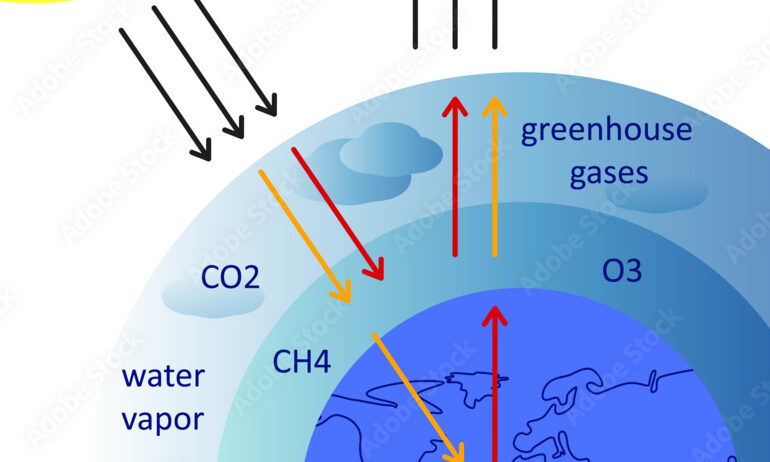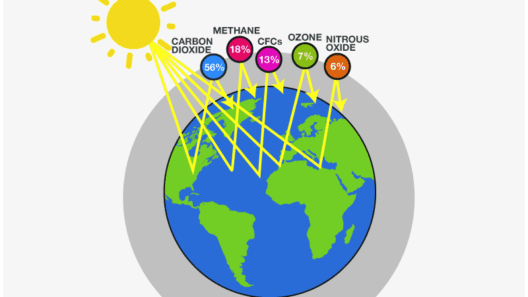The greenhouse effect is a natural phenomenon crucial to life on Earth. It occurs when certain gases in the atmosphere trap heat from the sun, creating a warm, habitable climate. While this process is vital for sustaining life, human activities have significantly amplified it, leading to dramatic changes in our climate. Understanding the greenhouse effect and its implications is essential for addressing the pressing issue of climate change.
To grasp the greenhouse effect, we must first comprehend how it functions. The sun radiates energy toward Earth, where some of this energy is absorbed by the surface, providing the warmth necessary for ecosystems to thrive. The Earth then radiates some of this energy back into space in the form of infrared radiation. However, greenhouse gases, primarily carbon dioxide (CO2), methane (CH4), and nitrous oxide (N2O), absorb this infrared radiation and re-radiate it in all directions, including back toward the Earth’s surface. This re-radiation effect leads to an increase in surface temperatures, hence the term “greenhouse effect.”
Greenhouse Gases: The Culprits Behind Climate Change
Greenhouse gases are an assemblage of gases that trap heat in the atmosphere. Carbon dioxide is the most abundant and well-known, primarily resulting from the combustion of fossil fuels, deforestation, and industrial processes. Its atmospheric concentration has surged due to human activities, contributing significantly to the enhanced greenhouse effect.
Methane is another potent greenhouse gas, possessing a heat-trapping capacity far greater than CO2, albeit present in smaller quantities. It is released during the production and transport of coal, oil, and natural gas and is also generated from livestock and other agricultural practices, as well as landfills. Methane’s potency means that even small increases in its concentration can have substantial effects on global temperatures.
Nitrous oxide, while less abundant than carbon dioxide and methane, is extremely effective at trapping heat, being approximately 298 times more potent than CO2 over a 100-year period. It primarily emanates from agricultural and industrial activities, as well as the combustion of fossil fuels and solid waste.
The Alarming Consequences of a Warming Planet
The direct consequence of enhanced greenhouse gases is global warming, which leads to various adverse effects on our climate and environment. One of the most visible consequences is the increase in global temperatures. According to scientific data, the average global temperature has risen significantly over the last century, resulting in a range of environmental changes.
Climate change manifests through more extreme weather patterns. Regions that were once temperate may experience an increase in droughts, while others face unprecedented levels of precipitation and flooding. These shifts threaten agriculture, water supply, and human health. For instance, crops can fail under extreme drought conditions or become inundated with floods, jeopardizing food security globally.
Additionally, the warming climate leads to the melting of polar ice caps and glaciers, contributing to rising sea levels. As sea levels increase, coastal areas are at risk of flooding, resulting in displacement of communities and loss of habitats. These changes underscore the interconnectedness of human activity and natural systems — a theme that is increasingly critical as we confront the realities of climate change.
Mitigating the Impacts: A Call to Action
Addressing the greenhouse effect and its impacts on climate change requires collective action at local, national, and global levels. Reducing emissions of greenhouse gases is paramount. Transitioning to renewable energy sources such as wind, solar, and hydroelectric power can significantly reduce our reliance on fossil fuels, a core factor in greenhouse gas emissions.
In addition to a shift in energy sources, enhancing energy efficiency in homes, buildings, and transportation is crucial. This can be achieved through better insulation, energy-efficient appliances, and more sustainable modes of transportation. Individuals can contribute by reducing car travel, supporting public transportation, or utilizing electric and hybrid vehicles.
Improving agricultural practices also plays a vital role in mitigating the greenhouse effect. Utilizing sustainable farming techniques, reducing food waste, and promoting plant-based diets can decrease emissions from agricultural sources. Additionally, protecting and restoring forests—nature’s carbon sinks—can help absorb CO2 from the atmosphere, enhancing carbon sequestration efforts.
Lastly, raising awareness and supporting policies aimed at combatting climate change are essential for driving systemic change. Educating ourselves and others about the importance of the greenhouse effect and its implications empowers communities to forge sustainable paths forward. Local initiatives, national legislation, and global agreements all play pivotal roles in shaping a future where environmental sustainability is paramount.
In conclusion, the greenhouse effect, while an essential aspect of our climate system, has been exacerbated by human activity. Understanding its mechanisms and consequences is crucial for navigating the challenges posed by climate change. By committing to sustainable practices and advocating for systemic change, we can mitigate these impacts and work towards a more stable climate for future generations.







